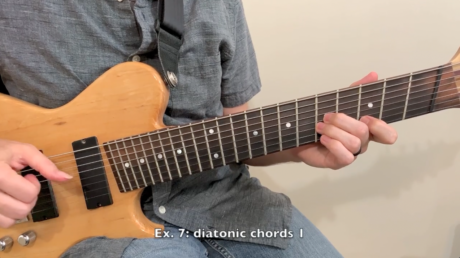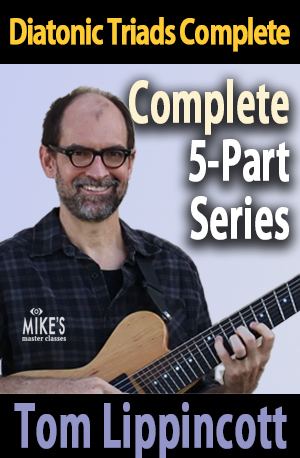Description
This bundle includes Tom Lippincott’s complete 5-part series on Diatonic Triads.
Diatonic Triads Complete pt. 1 – Traditional Triads Class Content | Tom Lippincott
Mastering the basic major, minor, diminished, and augmented triads is widely acknowledged as a crucial step in the development of any jazz musician. This is particularly important on an instrument like guitar which can be played both melodically and harmonically.
Triads form the basic building blocks of more complex harmonies as well as the upper part of these chords.
In this series of classes, we will systematically examine all of the traditional triads that are diatonic to the major, melodic minor, and harmonic minor scales and find many unique and creative uses for them, both for chords and for single-note lines. But the fun doesn’t stop at traditional triads; in this five-part class, we will also explore all of the three-note chords that are possible in the above three scales. This includes suspended triads, seventh chords with no fifth, seventh chords with no third, and clusters.
By practicing these five structures, guitarists can add many fresh and exciting sounds to their music. One advantage of three-note chords is that they tend to be easier to play and more “portable” than bigger four-, five-, and six-note chords. These shapes work exceptionally well for both comping and for supporting a melodic line with harmony.
Arpeggios built from this variety of three-note chords can also generate some interesting new melodic ideas.
In the first class, we will explore traditional triads, the roots of the harmonic tree. A command of these structures will be necessary in order to facilitate the exploration of the more exotic sounds in the subsequent classes.
Guitarists who have been through my Jazz Guitar Harmony part 2 and Jazz Guitar Harmony part 3 and absorbed the material on triads may find this class unnecessary. However, there are a few new concepts in this class that aren’t covered in the Jazz Guitar Harmony series.
Diatonic Triads Complete part 1: Traditional Triads covers:
- review of the theoretical basis of triads
- “piano style” versus “choir style” inversion on the guitar
- map of all inversions of major triads
- explanation of the concept of diatonic triads, with example exercises
- using diatonic cycles to gain fluency with inversions and voice leading
- exploration of open triads
- applying diatonic cycles of open and close triads to the melodic and harmonic minor scales
- examples of single note musical phrases incorporating all of the above
- using triads to harmonize a melodic line
- 59 minute running time
- includes 10 pages of written examples and exercises
- includes backing track for II V I musical example
- All musical examples from the video are provided in music notation, tablature, and chord grid form.
- Each example performance is shown in close-up view and titled and numbered for easy navigation.
Diatonic Chords Example Close-up View

Save Now When You Order the Complete Series
| Full Class + Download | |||
| Diatonic Triads Complete Part I Full Class + Download | 00:59:54 | ||
Diatonic Triads Complete pt. 2 – Suspended Triads Class Content | Tom Lippincott
In this second class from the diatonic triads series, we will explore suspended triads. These triads can give an impression of openness due to their lack of the 3rd interval. Since the 3rd interval is central to traditional triads and tonal harmony in general, suspended triads are useful for achieving a modal, harmonically nebulous sonority that is associated with more modern sounds. The so-called sus2 triad also falls into this family and will be discussed as well.
Diatonic Triads Complete part 2: Suspended Triads covers:
- introduction to all five types of diatonic triads
- definition of suspended chords and their history
- map of all inversions of suspended triads
- explanation of the concept of diatonic suspended triads, with example exercises
- using diatonic cycles, including contrapuntal movement, to gain fluency with inversions and voice leading
- exploration of open suspended triads
- alternate fingering for open sus triads
- applying diatonic cycles of open and close triads to the melodic and harmonic minor scales
- examples of single note musical phrases incorporating all of the above
- using sus triads derived from melodic minor over a minor II V I progression
- 54 minute running time
- includes 11 pages of written examples and exercises
- includes backing track for minor II V I musical example
- All musical examples from the video are provided in music notation, tablature, and chord grid form.
- Each example performance is shown in close-up view and titled and numbered for easy navigation.
Save Now on the Complete Series
| Full Class + Download | |||
| Diatonic Triads Complete Part II Full Class + Download | 00:54:08 | ||
Diatonic Triads Complete pt. 3 – 7th no 5th Class Content | Tom Lippincott
In this third class, we will explore 7th no 5th triads. This structure is simply a 7th chord with its 5th removed and is often referred to as a “shell voicing.” However, in this class we will be treating these “shell voicings” like three-note triads, which means finding all the inversions, registers, and string sets. This will yield many more uses than just the traditional shell voicing concept provides. 7th no 5th triads can have a more traditional, tonal sound than sus triads but when used imaginatively can also create fresh new sounds.
Diatonic Triads Complete part 3: 7th no 5th covers:
- explanation of 7th no 5th chords and their use as traditional shell voicings
- “piano style” versus “choir style” inversions on the guitar
- map of all inversions of 7th no 5th triads, plus diatonic harmonized scales on all string sets
- using diatonic cycles to gain fluency with inversions and voice leading, including contrapuntal variations
- exploration of open 7th no 5th triads
- arpeggiating 7th no 5th triads to create melodic ideas
- exploring 7th no 5th triads from the melodic and harmonic minor scales
- example of harmonized melodic line on the changes of “My Romance” utilizing material from the above
- 56 minute running time
- includes 13 pages of written examples and exercises
- includes backing track for “My Romance” musical example
- All musical examples from the video are provided in music notation, tablature, and chord grid form.
- Each example performance is shown in close-up view and titled and numbered for easy navigation.
Save Now on the Complete Series
| Full Class + Download | |||
| Diatonic Triads Complete Part III Full Class + Download | 00:56:47 | ||
Diatonic Triads Complete pt. 4 – 7th no 3rd Class Content | Tom Lippincott
In part four, we will explore 7th no 3rd triads. Like 7th no 5th triads, these are derived simply by removing one note from a traditional 7th chord although, in this case, the 3rd is removed. This fascinating structure creates a sound that is both traditional and tonal due to its derivation from 7th chords, and at the same time, open and ambiguous because of its lack of 3rd. In many ways, this configuration provides the best of both worlds.
Diatonic Triads Complete part 4: 7th no 3rd covers:
- explanation of 7th no 3rd chords
- “piano style” versus “choir style” inversions on the guitar
- map of all inversions of 7th no 3rd triads, plus diatonic harmonized scales on all string sets
- using diatonic cycles to gain fluency with inversions and voice leading, including contrapuntal variations
- exploration of open 7th no 3rd triads
- arpeggiating 7th no 3rd triads to create melodic ideas
- exploring 7th no 3rd triads from the melodic and harmonic minor scales
- single-note line and chordal phrases over major and minor II V I progressions to demonstrate real-world applications
- 51 minute running time
- includes 13 pages of written examples and exercises
- includes backing tracks for major and minor II V I musical examples
- All musical examples from the video are provided in music notation, tablature, and chord grid form.
- Each example performance is shown in close-up view and titled and numbered for easy navigation.
Save Now When You Order the Complete Series
| Full Class + Download | |||
| Diatonic Triads Complete Part IV Full Class + Download | 00:51:22 | ||
Diatonic Triads Complete pt. 5 – Clusters Class Content | Tom Lippincott
In this final class of the Diatonic Triads series, we will explore clusters. Simply stated, a three-note cluster consists of any three consecutive notes from a seven-note scale. We will start with the notes C, D, and E from the C major scale.
While some of the inversions of this structure played as a chord may prove difficult or even impossible on some string sets and/or fretboard locations, we will explore all the possibilities with a view toward finding the most practical examples. When this tight structure is inverted and opened up, it can create more playable shapes and also provide surprisingly open-sounding and unique sonorities.
Included Documentation
The document included entitled “Diatonic Triads Complete – Part 5: Clusters” by Tom Lippincott focuses on the concept of clusters within the context of diatonic triads for guitar. It explains how to construct clusters from any seven-note scale and explores their integration into guitar practice, including various inversions and voicings. The document also includes exercises and examples to demonstrate the practical application of these concepts on the guitar, aiming to enhance harmonic understanding and fretboard navigation.
Diatonic Triads Complete part 5: Clusters covers:
- explanation of clusters
- “piano style” versus “choir style” inversions on the guitar
- map of all inversions of 3-note clusters, plus diatonic harmonized scales on all string sets
- using diatonic cycles to gain fluency with inversions and voice leading, including contrapuntal variations
- exploration of open clusters
- substitution of occasional open clusters for impractical close clusters
- arpeggiating open clusters to create melodic ideas with wide intervallic leaps
- exploring clusters from the melodic and harmonic minor scales
- single-note line and chordal phrases over a minor II V I progression and over the chords of “My Romance” to demonstrate real-world applications
- 74 minute running time
- includes 13 pages of written examples and exercises
- includes backing track for II V I musical example
- All musical examples from the video are provided in music notation, tablature, and chord grid form.
- Each example performance is shown in close-up view and titled and numbered for easy navigation.
Save Now When You Order the Complete Series
| Full Class + Download | |||
| Diatonic Triads Complete Part V Full Class + Download | 01:14:22 | ||
| Diatonic Triads Complete Pt. 5: Ex. 12 | 00:00:09 | ||
| Diatonic Triads Complete Pt. 5: Ex. 13 | 00:00:13 | ||
| Diatonic Triads Complete Pt. 5: Ex. 14 | 00:00:14 | ||



Reviews
There are no reviews yet.